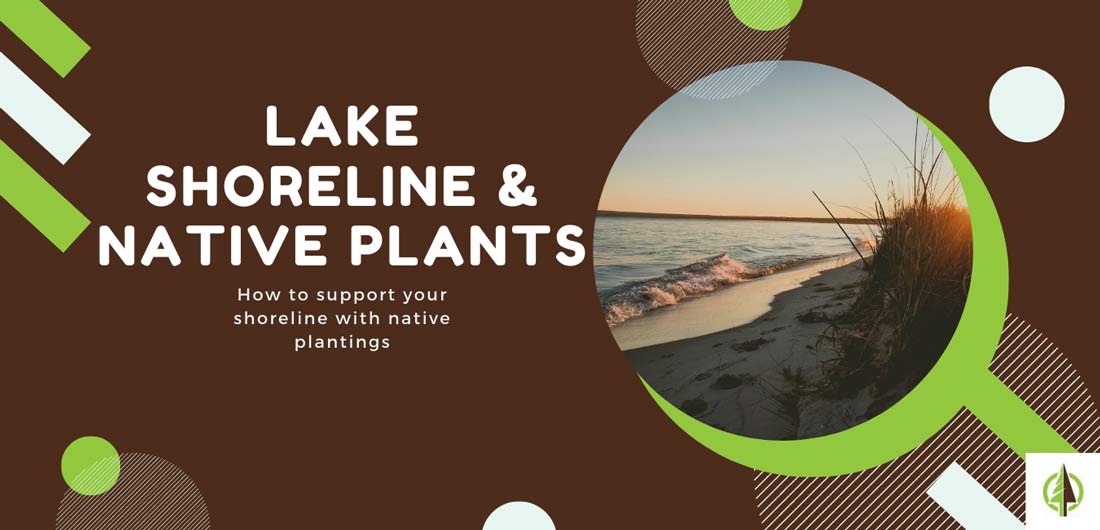With the beautiful Great Lakes that surround the Grand Traverse and Leelanau County area, protecting our shoreline is of the utmost importance. Major shorelines like Lake Michigan need to be protected, but so do those of our smaller lakes and rivers. While boulders and stone do effectively help with shoreline stabilization, one of the best tools to protect our shoreline and habitat, in general, is using native plants. But can a few plantings really do much? Let’s dive into how native plants can help your shoreline and our gorgeous area here in Northern Michigan.
How can native plants help maintain my shoreline?
Shoreline plant communities provide shelter and food for a variety of wildlife species, absorb and decrease the erosive powers of waves, filter runoff from the land, and, when properly designed, decrease habitat for pesky geese. Native plants assist in managing rainwater run-off and maintain healthy soils as their root systems are deep and keep soil stabilized. They also keep soil from becoming compacted.
Well-thought-out shoreline plantings can be aesthetically pleasing, used to enhance or frame a view, as well as provide season-long interest at the water’s edge.
How do I pick the right plants for my shoreline?
In order for native plants to survive, they need to be placed in the right area. The reference point for deciding which spot is the correct one is the ordinary high water mark (OHWM). Knowing the OHWM allows installers to know what type of conditions the plant will experience in a designated spot. The ordinary high water mark usually is a sign of where plants switch from water-dependent plants to terrestrial plants.
Trees and shrubs that can tolerate consistently wet soil, possible flooding , and wave energy can be installed between the water level and the OHWM. A few examples would be Buttonbush, Redstemmed dogwood, bog birch, silky dogwood, swamp rose, sandbar willow, and the black willow.
If you are looking to plant native trees and shrubs above the ordinary high water mark, there are several different options. They still need to be able to tolerate being moist, but flooding is not as big of an issue. Some great options are winterberry, common ninebark, red maple, black chokeberry, yellow birch, hackberry, honeylocust, swamp white oak, American elderberry, arrowwood, nannyberry.
Finally, planting well away from the high water mark, where drier soils can be found, there are still several great options for native trees and shrubs. Our favorites are shrubby cinquefoil, serviceberry, New Jersey Tea, Eastern redbud, alternate-leaf dogwood, American hazelnut, diervilla, ironwood, American elder, and red-berried elder.
Selecting a Qualified Landscaping Company for Shoreline Work
We recommend working with someone who is a certified Michigan Natural Shoreline Professional. These people go through extensive training and know all the ins and outs of permitting required to do nearly anything on a shoreline in Michigan. If the company does not have someone on staff who is a certified shoreline professional, they usually consult with one during the permitting process. Hiring someone who has a good understanding of the long-term impact shoreline work may have is vital for keeping our shores beautiful and usable.
Shoreline restoration is a delicate and difficult process. To learn more about what to expect, check out this blog.
Ready to get started on your landscaping project using native plantings in Grand Traverse or Leelanau County, MI? If so, meet with our team of experts, choose a solution to improve your property, and get ready to sit back, relax, and enjoy your beautiful outdoor space.
Image Source: High Water Mark Chart, Shoreline Buffer Cross Section
Get started today with a consultation!
Want tips and tricks for your lawn & landscaping?
Sign Up For Our Free Quarterly Newsletter
We take your personal information very seriously. We will not share any of the information you provide with any 3rd parties. Provided information will be used specifically to contact you in regards to your inquiry.

